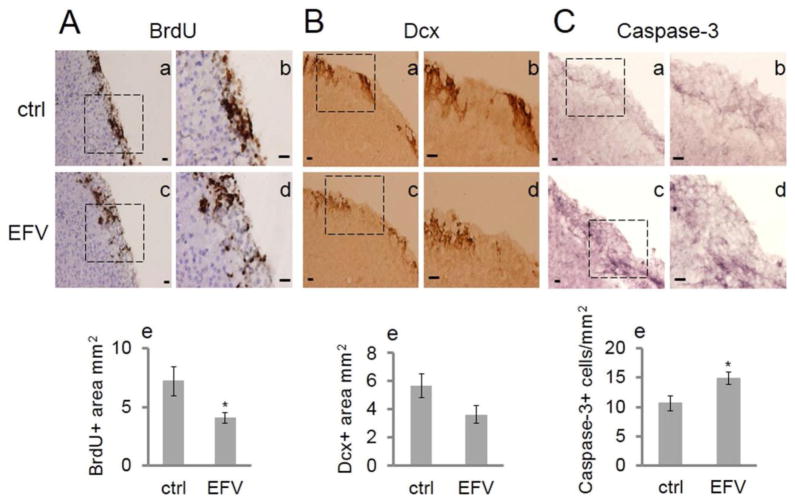Figure 5.
EFV administration impairs NSC proliferation and induces apoptosis in the SVZ. (A) Administration of EFV (20 mg/kg) impairs BrdU incorporation in the SVZ of C57BL/6J mice. Mice were administered daily IP injections of EFV or vehicle control (ctrl) for 4 weeks and BrdU administration for 5 consecutive days prior to euthanization. Sagittal sections were stained with BrdU antibody. (a, b) The square marked in (a) represents the vehicle control (ctrl)-treated group and is magnified in (b) (n = 7); (c) and (d) the square marked in (c) represents EFV treated group and is magnified in (d) (n = 8). Scale bar: 20 μm (in micrographs). (e) Quantitative data are represented by the bar graph. Each bar is presented as mean ± SEM (*p < 0.05). (B) Administration of EFV shows a trend to decrease Dcx expression in C57BL/6J mice in the SVZ. Sagittal sections from the same mice were stained by Dcx antibody. (a, b) The square marked in (a) represents the vehicle control (ctrl) group and is magnified in (b) (n = 7). (c, d) The square marked in (c) represents the EFV treatment group and is magnified in (d) (n = 8). Scale bars: 20 μm (in micrographs). (e) Quantitative data are represented in the bar graph. Each bar is presented as mean ± SEM (p = 0.08). (C) Administration of EFV enhances active caspase-3 expression in the SVZ. Sagittal sections from the same mice were stained by active caspase-3 antibody to evaluate apoptosis in the SVZ of C57BL/6J mice. (a, b) The square marked in (a) represents the vehicle control (ctrl) group and is magnified in (b) (n = 7). (c, d) The square in (c) represents the EFV treatment group (n = 8) and is magnified in (d). Scale bars: 20 μm (in micrographs). (e) Quantitative data are represented in the bar graph. Data are presented as mean ± SEM (*p < 0.05).

